Multi-Stimuli-Responsive Fluorescent Molecule with AIE and TICT Properties Based on 1,8-Naphthalimide
Abstract
:1. Introduction
2. Results and Discussion
2.1. Synthesis and Characterization
2.2. Polarity Sensitive Fluorescent Behaviors
2.3. Thermosensitive Fluorescent Behaviors
2.4. Acid-Triggered Fluorescence Switch
2.5. Reversible Mechanochromism Behavior
3. Conclusions
4. Materials and Methods
4.1. Materials
4.2. Instrumentations and Methods
Supplementary Materials
Author Contributions
Funding
Data Availability Statement
Conflicts of Interest
References
- Song, J.M.; Zhou, Y.H.; Pan, Z.C.; Hu, Y.; He, Z.Y.; Tian, H.; Ma, X. An elastic organic crystal with multilevel stimuli- responsive room temperature phosphorescence. Matter 2023, 6, 2005. [Google Scholar] [CrossRef]
- Yan, Q.; Xu, J.Y.; Luo, M.; Lu, J.X.; Ren, J.; Wang, S. Pyrene-dithienylethene-tetra(tri)phenylethylene triads: Photocontrolled intramolecular energy transfer and photochromic fluorescence switching. Dyes Pigm. 2023, 214, 111231. [Google Scholar] [CrossRef]
- Xue, K.; Wang, C.; Wang, J.X.; Lv, S.Y.; Hao, B.Y.; Zhu, C.L.; Tang, B.Z. A Sensitive and Reliable Organic Fluorescent Nanothermometer for Noninvasive Temperature Sensing. J. Am. Chem. Soc. 2021, 143, 14147. [Google Scholar] [CrossRef] [PubMed]
- Yu, H.L.; Zhao, B.; Guo, J.B.; Pan, K.; Deng, J.P. Stimuli-responsive circularly polarized luminescent films with tunable emission. J. Mater. Chem. C 2020, 8, 1459. [Google Scholar] [CrossRef]
- Horak, E.; Hranjec, M.; Vianello, R.; Steinberg, I.M. Reversible pH switchable aggregation-induced emission of self assembled benzimidazole-based acrylonitrile dye in aqueous solution. Dyes Pigm. 2017, 142, 108. [Google Scholar] [CrossRef]
- Cao, J.; Liu, Q.M.; Bai, S.J.; Wang, H.C.; Ren, X.C.; Xu, Y.X. Ladder-Type Dye with Large Transition Dipole Moment for Solvatochromism and Microphase Visualization. ACS Appl. Mater. Interfaces 2019, 11, 29814. [Google Scholar] [CrossRef] [PubMed]
- Chepak, A.; Balatskiy, D.; Tutov, M.; Mironenko, A.; Bratskaya, S. Light Harvesting Nanoprobe for Trace Detection of Hg2+ in Water. Molecules 2023, 28, 1633. [Google Scholar] [CrossRef]
- Zhou, Y.S.; Jin, L.M.; Chen, J.Q.; Hong, W.; Liang, G.D.; Qin, W. Five-in-one: Dual-mode ultralong persistent luminescence with multiple responses from amorphous polymer films. Chem. Eng. J. 2023, 463, 142506. [Google Scholar] [CrossRef]
- Sun, S.Y.; Wang, J.; Ma, L.W.; Ma, X.; Tian, H. A Universal Strategy for Organic Fluid Phosphorescence Materials. Angew. Chem. Int. Ed. 2021, 60, 18557. [Google Scholar] [CrossRef]
- Li, S.Z.; Yan, D.P. Two-Component Aggregation-Induced Emission Materials: Tunable One/Two-Photon Luminescence and Stimuli-Responsive Switches by Co-Crystal Formation. Adv. Opt. Mater. 2018, 6, 1800445. [Google Scholar] [CrossRef]
- Wang, Q.; Zhang, Q.; Zhang, Q.W.; Li, X.; Zhao, C.X.; Xu, T.Y.; Qu, D.H.; Tian, H. Color-tunable single-fluorophore supramolecular system with assembly-encoded emission. Nat. Commun. 2020, 11, 158. [Google Scholar] [CrossRef] [PubMed]
- Liu, C.W.; Steppert, A.K.; Liu, Y.Z.; Weis, P.; Hu, J.Y.; Nie, C.; Xu, W.C.; Kuehne, A.J.C.; Wu, S. A Photopatternable Conjugated Polymer with Thermal-Annealing-Promoted Interchain Stacking for Highly Stable Anti-Counterfeiting Materials. Adv. Mater. 2023, 35, 2303120. [Google Scholar] [CrossRef]
- Shi, Y.R.; Zhao, S.Y.; Zhou, Y.; Zang, Z.G. Variable halide perovskites: Diversification of anti-counterfeiting applications. Mater. Chem. Front. 2023, 7, 6085. [Google Scholar] [CrossRef]
- Zhang, X.Y.; Wang, S.Y.; Fu, Z.Y.; Wang, C.Y.; Yang, Z.Q.; Gao, Y.; Liu, H.C.; Zhang, S.T.; Gu, C.; Yang, B. Switching Monomer-to-Excimer Fluorescence by Noncovalent Interaction Competition Strategy. Adv. Funct. Mater. 2023, 33, 2301228. [Google Scholar] [CrossRef]
- Henwood, A.F.; Curtin, N.; Estalayo-Adrian, S.; Savyasachi, A.J.; Gudmundsson, T.A.; Lovitt, J.I.; Sigurvinsson, L.C.; Dalton, H.L.; Hawes, C.S.; Jacquemin, D.; et al. Time-resolved fluorescence imaging with color-changing, “turn-on/turn-on AIE nanoparticles”. Chem 2024, 10, 578. [Google Scholar] [CrossRef]
- Dong, H.Q.; Wei, T.B.; Ma, X.Q.; Yang, Q.Y.; Zhang, Y.F.; Sun, Y.J.; Shi, B.B.; Yao, H.; Zhang, Y.M.; Lin, Q. 1,8-Naphthalimide-based fluorescent chemosensors: Recent advances and perspectives. J. Mater. Chem. C 2020, 8, 13501. [Google Scholar] [CrossRef]
- Gopikrishna, P.; Meher, N.; Iyer, P.K. Functional 1,8-Naphthalimide AlE/AIEEgens: Recent Advances and Prospects. ACS Appl. Mater. Interfaces 2018, 10, 12081. [Google Scholar] [CrossRef]
- Nie, W.; Hu, L. Design of 1,8-Naphthalimide-Based Fluorescent Functional Molecules for Biological Application: A Review. Chemistryselect 2024, 9, e202303779. [Google Scholar] [CrossRef]
- Poddar, M.; Sivakumar, G.; Misra, R. Donor-acceptor substituted 1,8-naphthalimides: Design, synthesis, and structure-property relationship. J. Mater. Chem. C 2019, 7, 14798. [Google Scholar] [CrossRef]
- Sharma, H.; Hearn, K.N.; Ranieri, A.M.; Caporale, C.; Massi, M.; Pfeffer, F.M. A rhodamine-naphthalimide-benzamide trichromophoric system with solid-state and multiple solvent dependent aggregate emissive properties. Mater. Chem. Front. 2021, 5, 5024. [Google Scholar] [CrossRef]
- Han, C.; Sun, S.B.; Ji, X.; Wang, J.Y. Recent advances in 1,8-naphthalimide-based responsive small-molecule fluorescent probes with a modified C4 position for the detection of biomolecules. TrAC-Trend. Anal. Chem. 2023, 167, 117242. [Google Scholar] [CrossRef]
- Nhu, Q.P.N.; Abedi, S.A.A.; Chanmungkalakul, S.; Sukwattanasinitt, M.; Chang, Y.T.; Rashatasakhon, P. Solvatochromic fluorescent ethynyl naphthalimide derivatives for detection of water in organic solvents. Dyes Pigm. 2024, 227, 112188. [Google Scholar] [CrossRef]
- Jovaisaite, J.; Baronas, P.; Jonusauskas, G.; Gudeika, D.; Gruodis, A.; Grazulevicius, J.V.; Jursenas, S. TICT compounds by design: Comparison of two naphthalimide-π-dimethylaniline conjugates of different lengths and ground state geometries. Phys. Chem. Chem. Phys. 2023, 25, 2411. [Google Scholar] [CrossRef] [PubMed]
- Bakov, V.V.; Georgiev, N.I.; Bojinov, V.B. A Novel Fluorescent Probe for Determination of pH and Viscosity Based on a Highly Water-Soluble 1,8-Naphthalimide Rotor. Molecules 2022, 27, 7556. [Google Scholar] [CrossRef] [PubMed]
- Mo, L.T.; He, W.Q.; Tang, Y.H.; Liang, D.L.; Yang, C.; Lin, W.Y. A novel 1,8-naphthalimide-based fluorescent chemosensor for the detection of HSA in living cells. Luminescence 2023, 38, 83. [Google Scholar] [CrossRef] [PubMed]
- Kumari, A.; Sharma, S.; Sengupta, S. Molecular rotors of naphthalimide and benzodithiophene as effective solvent polarity probes, temperature sensors, and for g-C3N4 sensitization. Photochem. Photobiol. 2024. [Google Scholar] [CrossRef] [PubMed]
- Luo, J.D.; Xie, Z.L.; Lam, J.W.Y.; Cheng, L.; Chen, H.Y.; Qiu, C.F.; Kwok, H.S.; Zhan, X.W.; Liu, Y.Q.; Zhu, D.B.; et al. Aggregation-induced emission of 1-methyl-1,2,3,4,5-pentaphenylsilole. Chem. Commun. 2001, 18, 1740–1741. [Google Scholar] [CrossRef] [PubMed]
- He, Z.K.; Ke, C.Q.; Tang, B.Z. Journey of Aggregation-Induced Emission Research. Acs Omega 2018, 3, 3267. [Google Scholar] [CrossRef] [PubMed]
- Tu, Y.J.; Zhao, Z.; Lam, J.W.Y.; Tang, B.Z. Mechanistic connotations of restriction of intramolecular motions (RIM). Natl. Sci. Rev. 2021, 8, nwaa260. [Google Scholar] [CrossRef]
- Sasaki, S.; Suzuki, S.; Sameera, W.M.C.; Igawa, K.; Morokuma, K.; Konishi, G. Highly Twisted N, N’-Dialkylamines as a Design Strategy to Tune Simple Aromatic Hydrocarbons as Steric Environment-Sensitive Fluorophores. J. Am. Chem. Soc. 2016, 138, 8194. [Google Scholar] [CrossRef]
- Würthner, F. Aggregation-Induced Emission (AIE): A Historical Perspective. Angew. Chem. Int. Ed. 2020, 59, 14192. [Google Scholar] [CrossRef] [PubMed]
- Yang, L.L.; Wang, H.R.; Zhang, J.Y.; Wu, B.; Li, Q.Y.; Chen, J.Y.; Tang, A.L.; Lam, J.W.Y.; Zhao, Z.; Yang, S.; et al. Understanding the AIE phenomenon of nonconjugated rhodamine derivatives via aggregation-induced molecular conformation change. Nat. Commun. 2024, 15, 999. [Google Scholar] [CrossRef] [PubMed]
- Qu, Y.; Wang, L.L.; Wu, J.W.; Rui, Y.C.; Cao, J.; Xu, J.L. 4-Phenyl-1,8-naphthalimides: Brightness and tuning emission over widely visible gamut in different aggregated states. Dyes Pigm. 2018, 148, 99. [Google Scholar] [CrossRef]
- Li, Y.; Cai, Z.; Gu, J.Y.; Chen, J.H.; Zhang, Y. Naphthalimide-based Functional Glycopolymeric Nanoparticles as Fluorescent Probes for Selective Imaging of Tumor Cells. Chem. Eur. J. 2024, 30, e202304165. [Google Scholar] [CrossRef] [PubMed]
- Yin, Y.; Chen, Z.; Fan, C.B.; Liu, G.; Pu, S.Z. 1,8-Naphthalimide-Based Highly Emissive Luminophors with Various Mechanofluorochromism and Aggregation-Induced Characteristics. Acs Omega 2019, 4, 14324. [Google Scholar] [CrossRef] [PubMed]
- Christopherson, C.J.; Mayder, D.M.; Poisson, J.; Paisley, N.R.; Tonge, C.M.; Hudson, Z.M. 1,8-Naphthalimide-Based Polymers Exhibiting Deep-Red Thermally Activated Delayed Fluorescence and Their Application in Ratiometric Temperature Sensing. ACS Appl. Mater. Interfaces 2020, 12, 20000. [Google Scholar] [CrossRef]
- Qi, Q.K.; Huang, L.; Yang, R.Q.; Li, J.; Qiao, Q.L.; Xu, B.; Tian, W.J.; Liu, X.G.; Xu, Z.C. Rhodamine-naphthalimide demonstrated a distinct aggregation-induced emission mechanism: Elimination of dark-states via dimer interactions (EDDI). Chem. Commun. 2019, 55, 1446. [Google Scholar] [CrossRef]
- Huang, W.L.; Jiang, N.; Lv, X.Y.; Qu, Y.; Zhang, X.; Wang, L. Naphthalimide-based AIE probe for direct and rapid detection of HSA in urine sample. Dyes Pigm. 2024, 221, 111820. [Google Scholar] [CrossRef]
- Zhou, H.M.; Huang, W.L.; Qu, Y.; Zhang, Y.Q.; Jiang, N.; Lv, X.Y.; Rui, Y.C.; Wang, L. Temperature-responsive polymeric sensors based on triphenylamine linked naphthalimide with red aggregation-induced emission. Dyes Pigm. 2023, 216, 111356. [Google Scholar] [CrossRef]
- Ni, Y.H.; Sun, Z.M.; Wang, Y.L.; Nour, H.F.; Sue, A.C.H.; Finney, N.S.; Baldridge, K.K.; Olson, M.A. Versatile hydrochromic fluorescent materials based on a 1,8-naphthalimide integrated fluorophore-receptor system. J. Mater. Chem. C 2019, 7, 7399. [Google Scholar] [CrossRef]
- Elgadi, S.A.; Cai, Y.; Hudson, Z.M. Thermally activated delayed fluorescence and mechanochromism in napthalimide-azatriangulenes. J. Mater. Chem. C 2023, 11, 11589. [Google Scholar] [CrossRef]
- Rotkiewicz, K.; Grellmann, K.H.; Grabowski, Z.R. Reinterpretation of the anomalous fluorescense of p-n,n-dimethylamino-benzonitrile. Chem. Phys. Lett. 1973, 19, 315. [Google Scholar] [CrossRef]
- Kucheryavy, P.; Li, G.F.; Vyas, S.; Hadad, C.; Glusac, K.D. Electronic Properties of 4-Substituted Naphthalimides. J. Phys. Chem. A 2009, 113, 6453. [Google Scholar] [CrossRef] [PubMed]
- Banthia, S.; Samanta, A. Influence of structure on the unusual spectral behavior of 4-dialkylamino-1,8-naphthalimide. Chem. Lett. 2005, 34, 722. [Google Scholar] [CrossRef]
- Chen, C.; Fang, C. Fluorescence Modulation by Amines: Mechanistic Insights into Twisted Intramolecular Charge Transfer (TICT) and Beyond. Chemosensors 2023, 11, 87. [Google Scholar] [CrossRef]
- Feng, J.; Tian, K.J.; Hu, D.H.; Wang, S.Q.; Li, S.Y.; Zeng, Y.; Li, Y.; Yang, G.Q. A Triarylboron-Based Fluorescent Thermometer: Sensitive Over a Wide Temperature Range. Angew. Chem. Int. Ed. 2011, 50, 8072. [Google Scholar] [CrossRef] [PubMed]
- Zhang, K.; Zhou, X.; Li, S.; Zhao, L.; Hu, W.; Cai, A.; Zeng, Y.; Wang, Q.; Wu, M.; Li, G.; et al. A General Strategy for Developing Ultrasensitive “Transistor-Like” Thermochromic Fluorescent Materials for Multilevel Information Encryption. Adv. Mater. 2023, 35, 2305472. [Google Scholar] [CrossRef]
- Tu, Y.; Cao, J.; Zhang, M.; Liu, M.; Huang, C.; Li, Y.; Wang, C. Dual Detection of Temperature and Chiral Amino Acid Using Triphenylamine-Based Fluorescent Probes. ChemistrySelect 2022, 7, 202203323. [Google Scholar] [CrossRef]
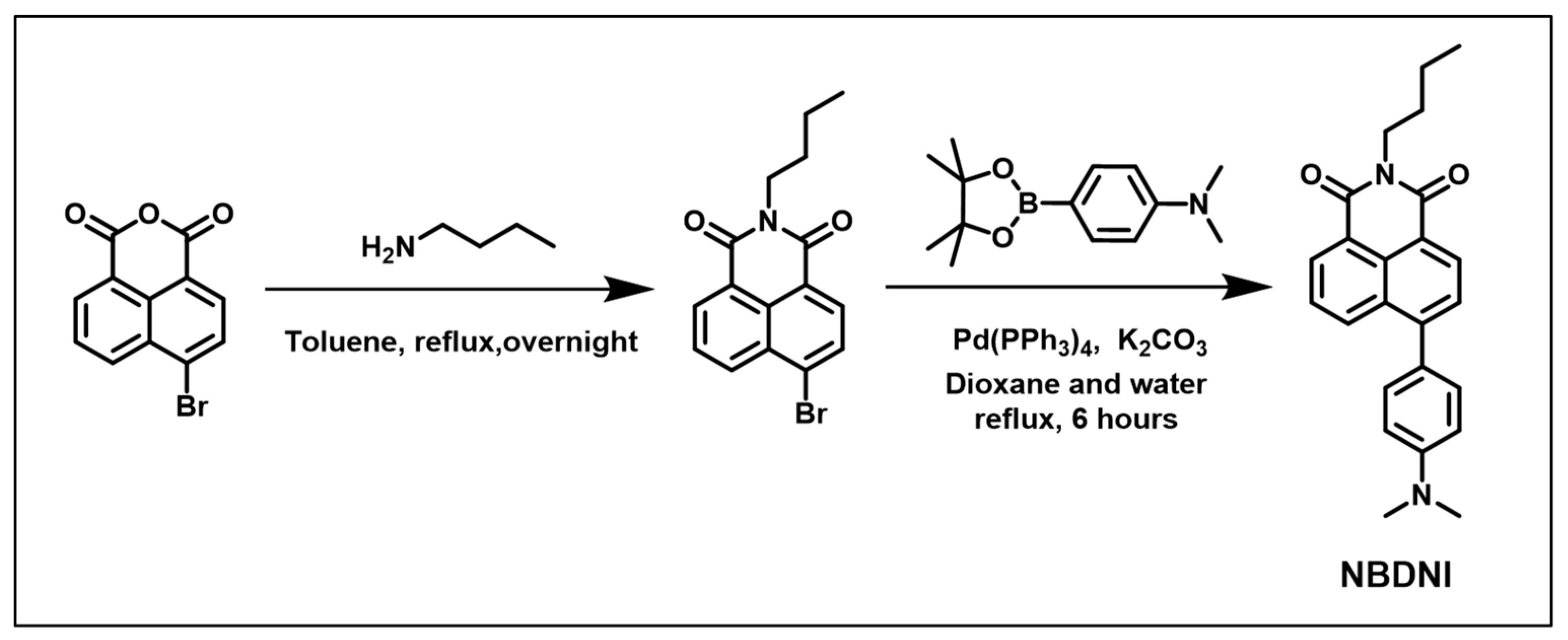

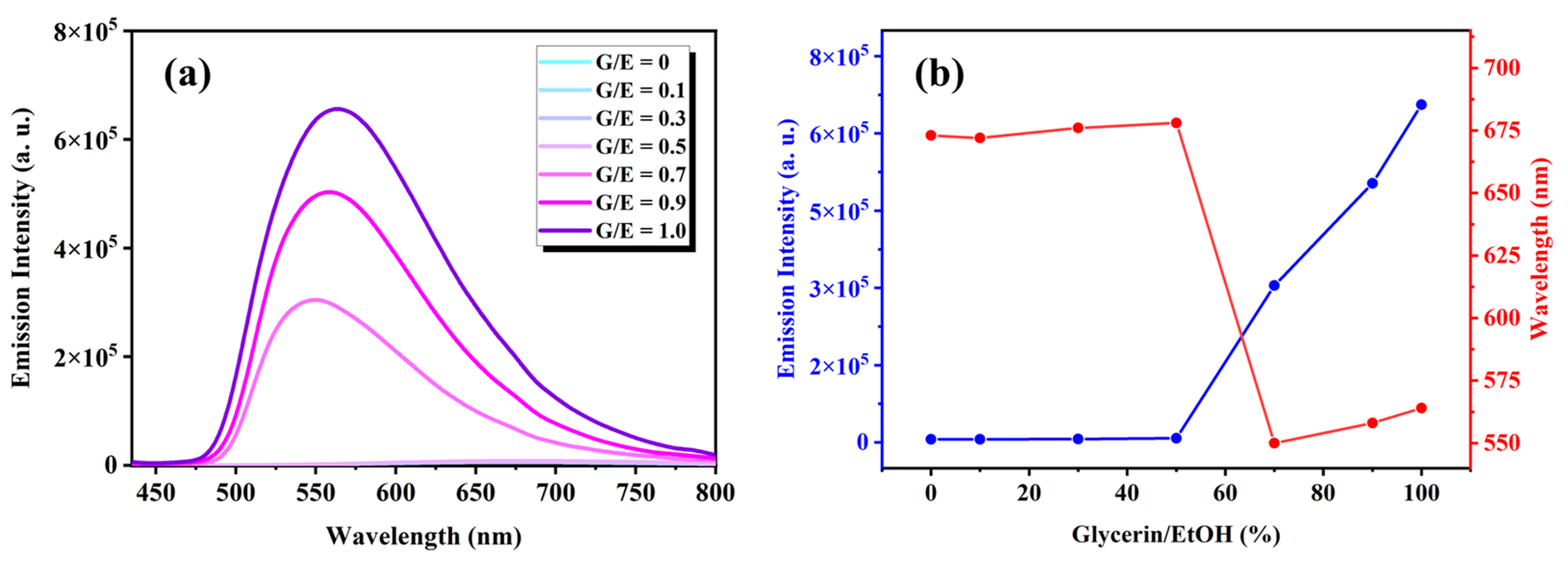
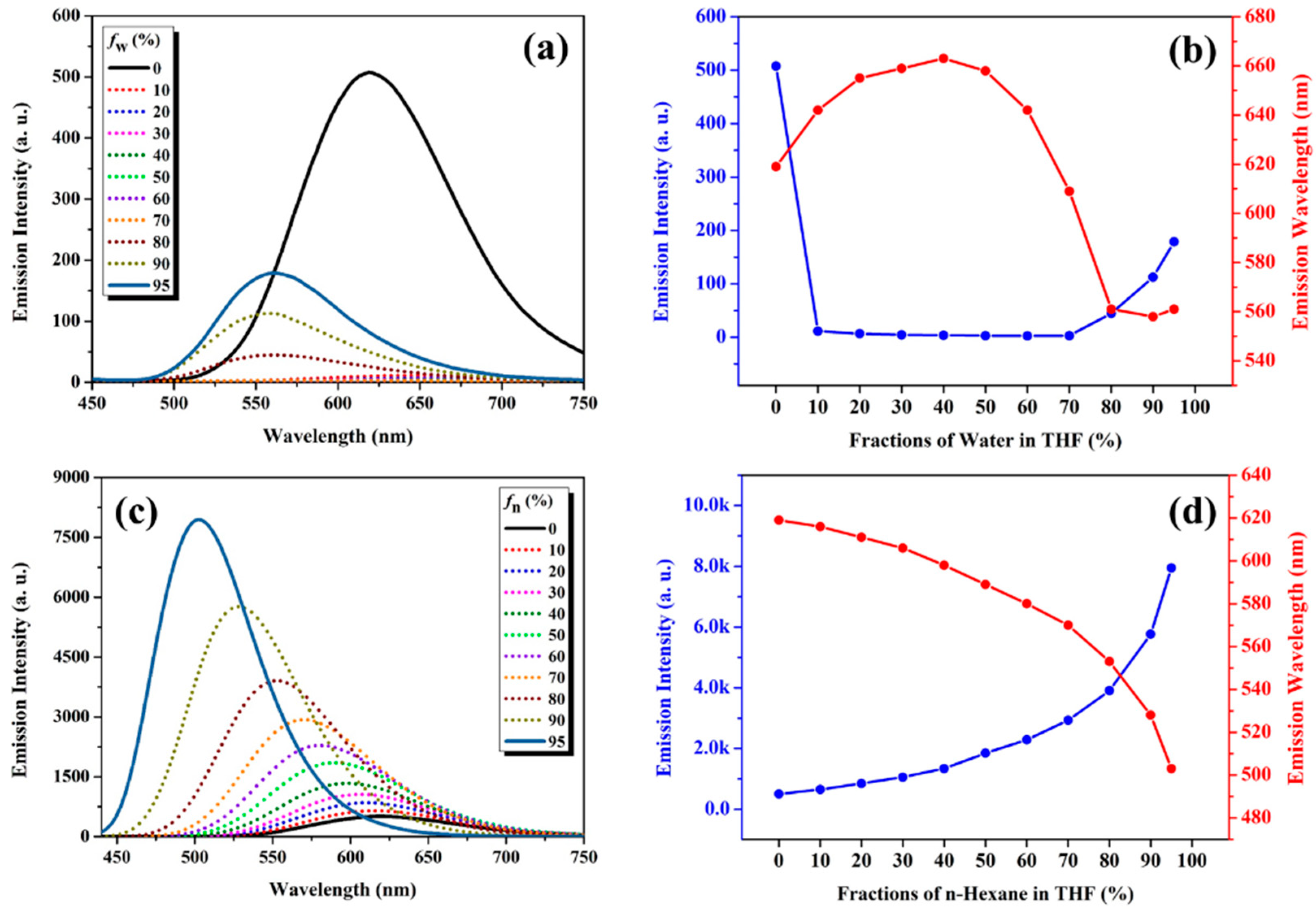
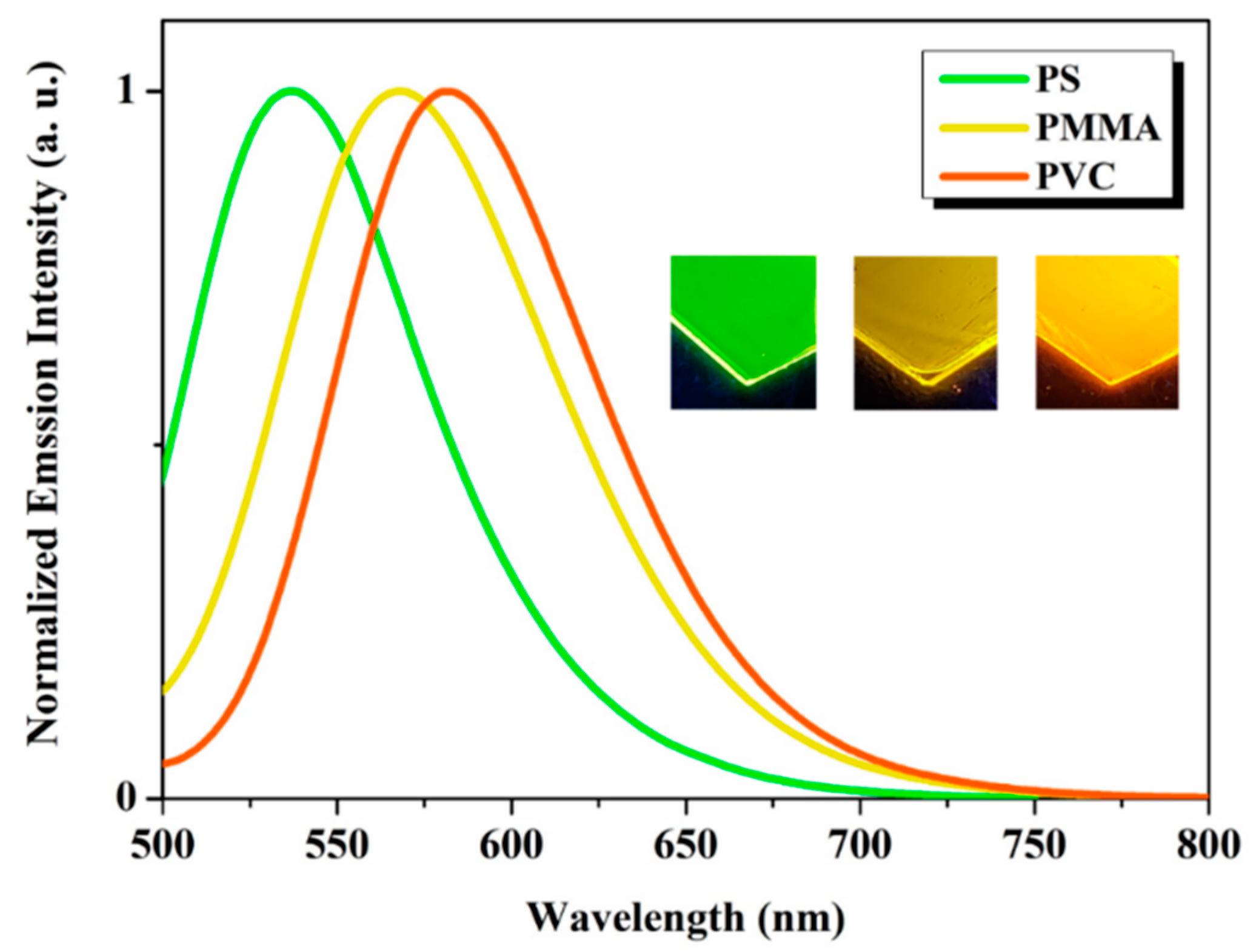

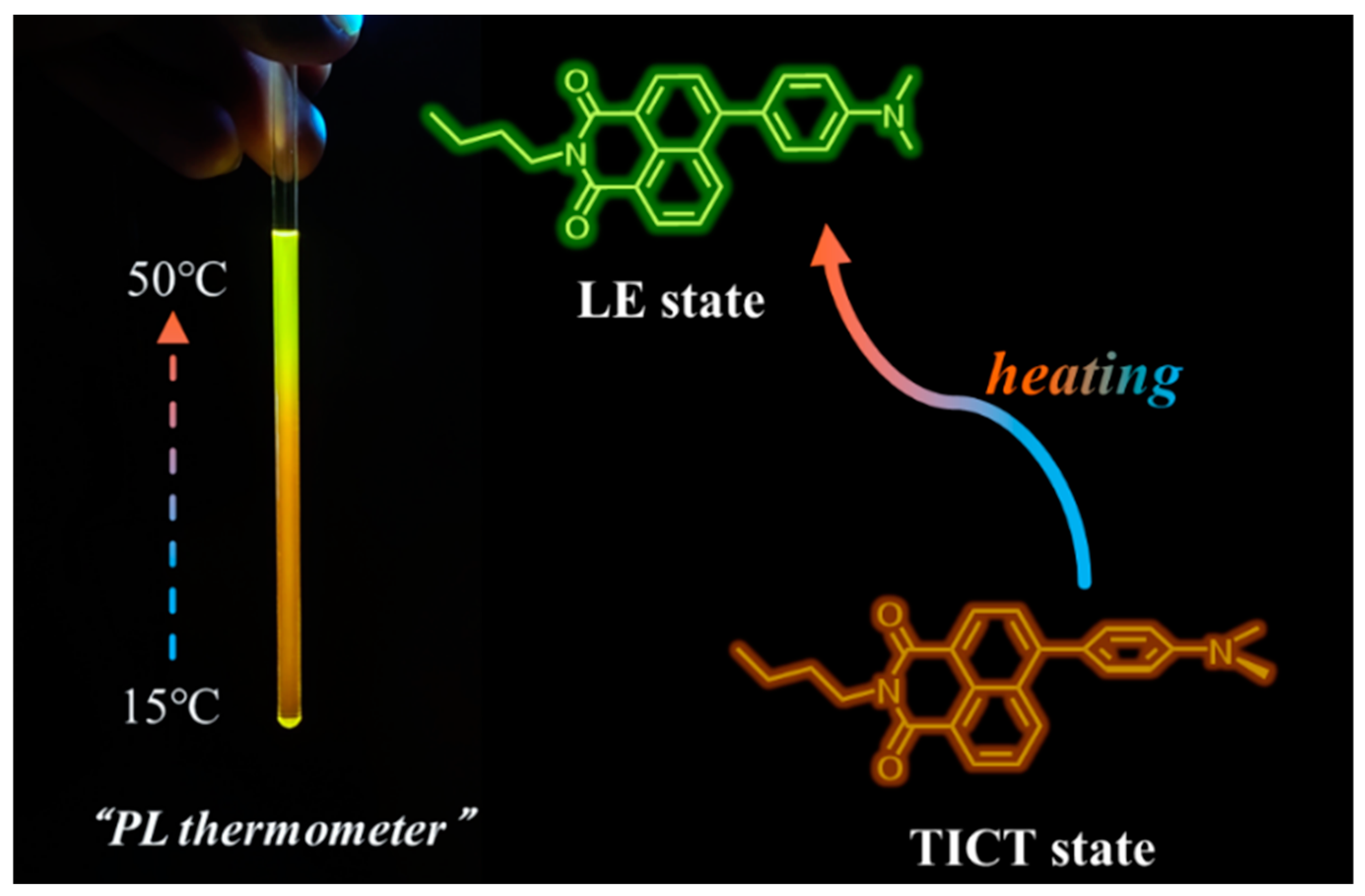
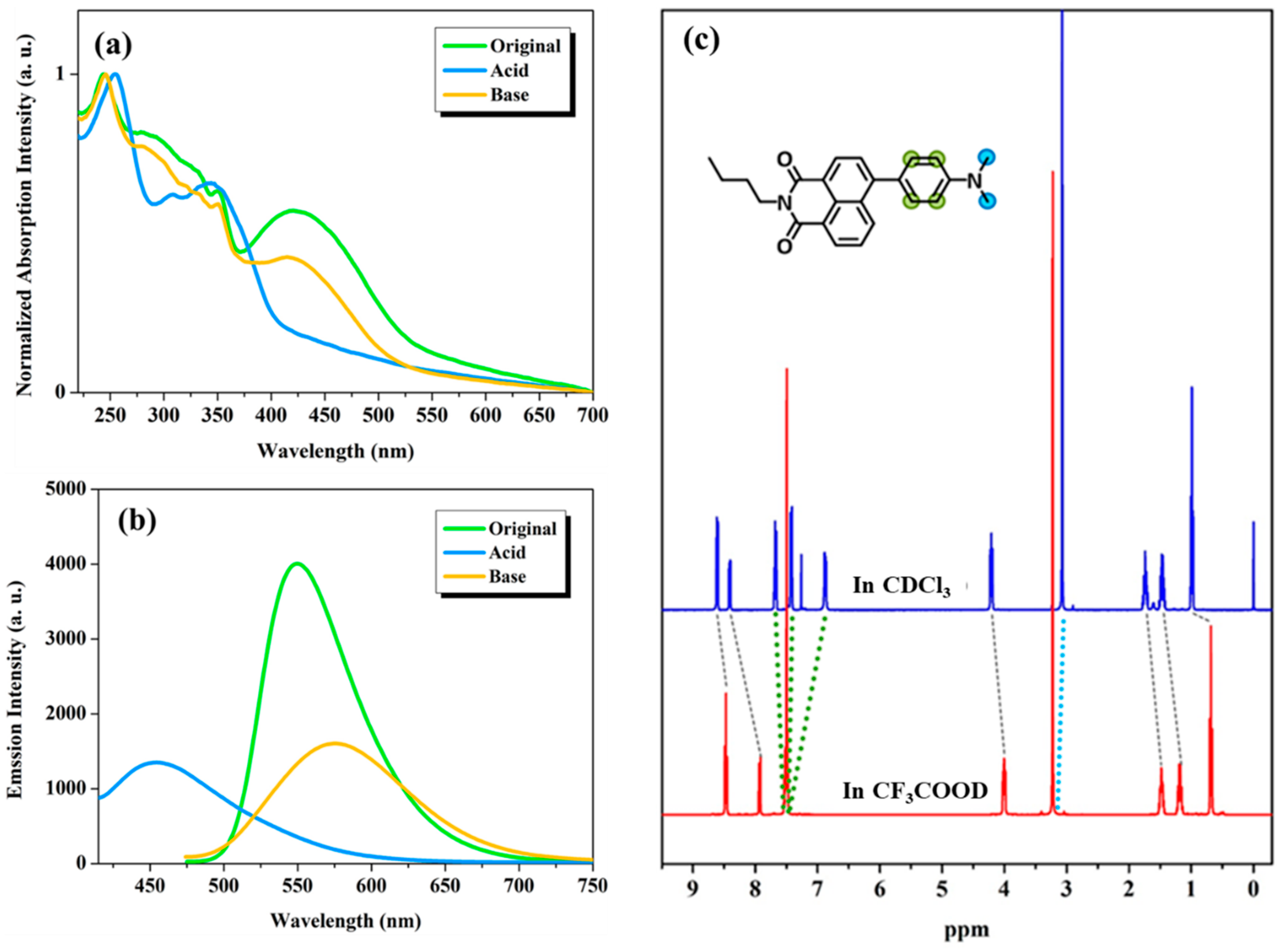
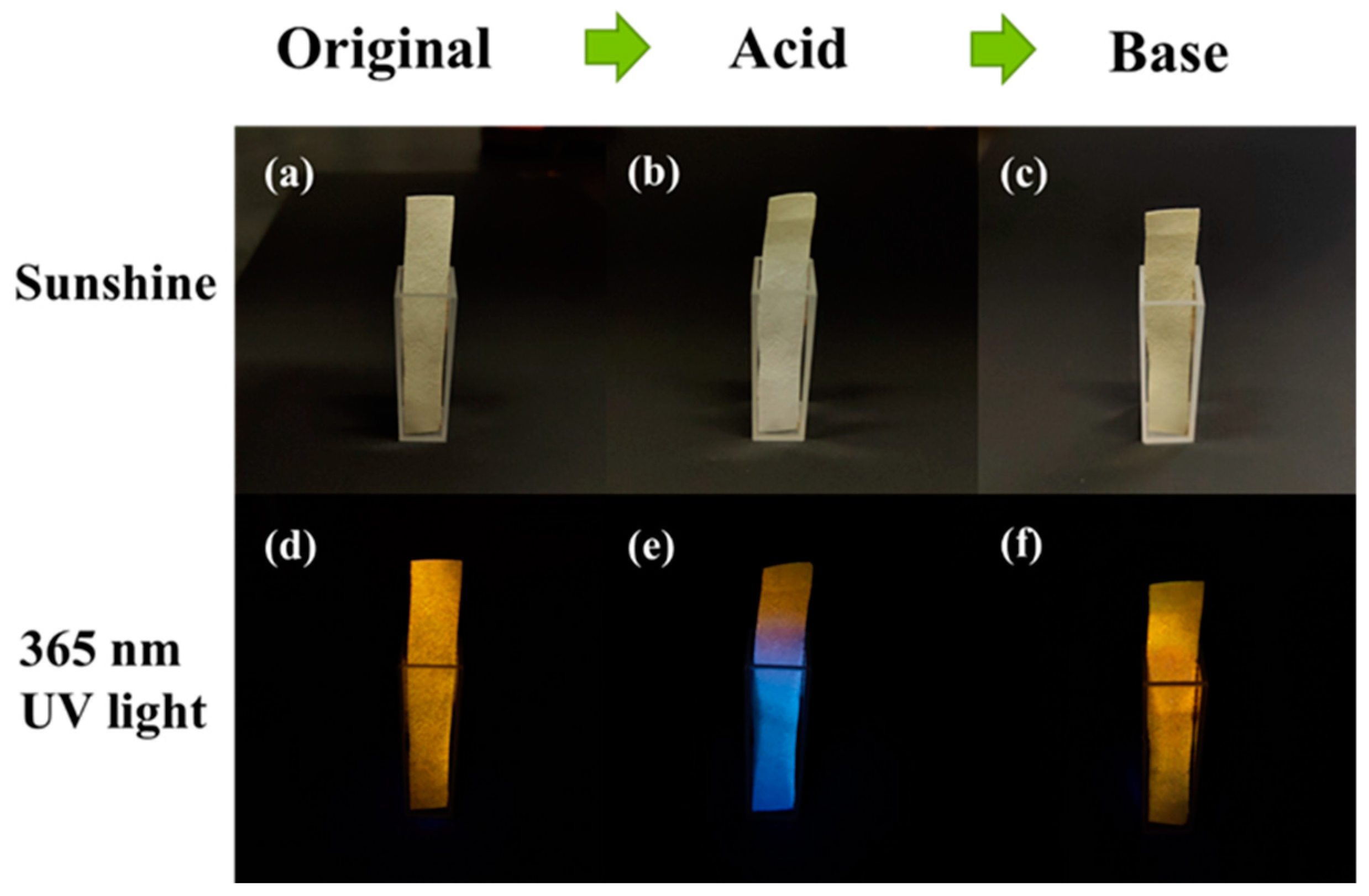

| Solvents | λab (nm) | λem (nm) | τ (ns) | Stokes Shift (nm) | Ø (%) | |
|---|---|---|---|---|---|---|
| Hexane | 403 | 18.9 | 476 | 4.03 | 73 | 61.7 |
| CCl4 | 411 | 13.4 | 499 | 4.05 | 88 | 58.3 |
| Tol | 419 | 16.6 | 542 | 5.38 | 123 | 32.6 |
| DOX | 417 | 15.9 | 567 | 4.85 | 150 | 25.6 |
| PhCl | 430 | 15.6 | 579 | 6.67 | 149 | 24.2 |
| CF | 431 | 15.9 | 585 | 7.06 | 154 | 19.3 |
| THF | 424 | 16.0 | 619 | - | 195 | 16.4 |
| EtOH | 432 | 15.4 | 673 | - | 241 | - |
Disclaimer/Publisher’s Note: The statements, opinions and data contained in all publications are solely those of the individual author(s) and contributor(s) and not of MDPI and/or the editor(s). MDPI and/or the editor(s) disclaim responsibility for any injury to people or property resulting from any ideas, methods, instructions or products referred to in the content. |
© 2024 by the authors. Licensee MDPI, Basel, Switzerland. This article is an open access article distributed under the terms and conditions of the Creative Commons Attribution (CC BY) license (https://creativecommons.org/licenses/by/4.0/).
Share and Cite
Yu, Y.; Qiang, N.; Liu, Z.; Lu, M.; Shen, Y.; Zou, J.; Yang, J.; Liu, G. Multi-Stimuli-Responsive Fluorescent Molecule with AIE and TICT Properties Based on 1,8-Naphthalimide. Nanomaterials 2024, 14, 1255. https://doi.org/10.3390/nano14151255
Yu Y, Qiang N, Liu Z, Lu M, Shen Y, Zou J, Yang J, Liu G. Multi-Stimuli-Responsive Fluorescent Molecule with AIE and TICT Properties Based on 1,8-Naphthalimide. Nanomaterials. 2024; 14(15):1255. https://doi.org/10.3390/nano14151255
Chicago/Turabian StyleYu, Yan, Na Qiang, Zhu Liu, Ming Lu, Yuqiu Shen, Jiao Zou, Jinyu Yang, and Guocong Liu. 2024. "Multi-Stimuli-Responsive Fluorescent Molecule with AIE and TICT Properties Based on 1,8-Naphthalimide" Nanomaterials 14, no. 15: 1255. https://doi.org/10.3390/nano14151255





